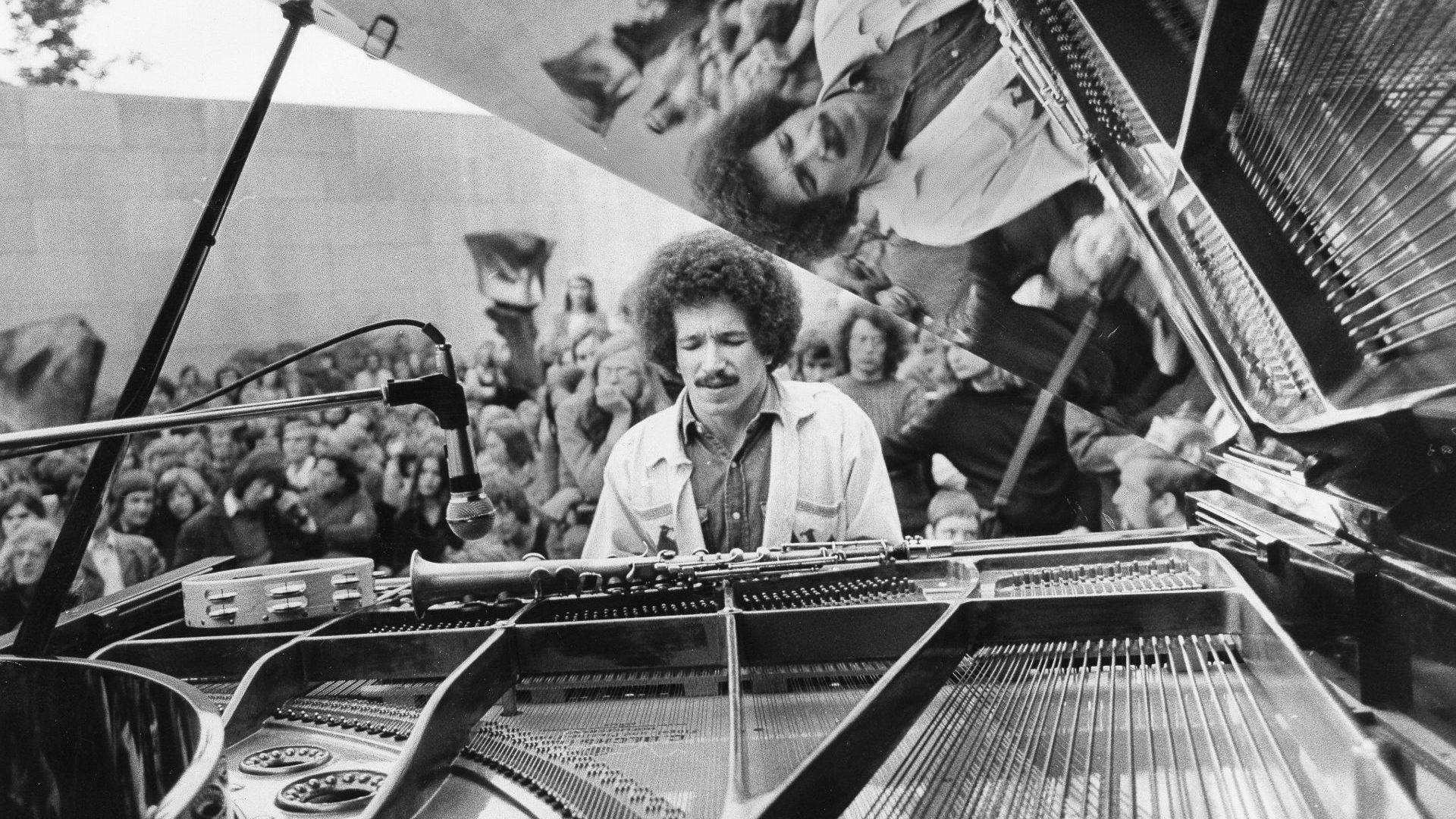“How do you feel when you’re playing?” the interviewer asks jazz bass player Paul Morgan. Thirty seconds of silence pass as Morgan visibly struggles to find an answer, and fails.
The scene takes place in a feature-length film documentary called Music for Black Pigeons, which won the Jury’s Special Award at the Venice Biennale in 2022. It was screened last year in more than 85 cinemas across Germany, but is yet to be seen in the UK or the USA.
The film-makers followed the Danish guitarist Jakob Bro for 14 years as he worked with a variety of fellow jazz musicians in both Europe and America. Along with the music, all of them have one thing in common: the record label ECM, based in Munich.
Morgan is not the only one lost for words during the course of the film. The label’s founder and chief record producer, Manfred Eicher, is similarly unable to articulate his feelings about the music he has surrounded himself with since founding ECM (Edition of Contemporary Music) in 1969.
Their silence ought to be excruciating, but it isn’t. In fact, ECM trades on its reputation for making “the most beautiful sound after silence”. In Music for Black Pigeons it is notable how few words pass between the musicians; they communicate through the shared creation of music.
ECM has released around 2,000 albums across various genres, including the work of modern classical composers such as Arvo Pärt, but the label is chiefly known for its production of jazz records with a distinctive “European” sound. Like jazz itself, this sound is hard to describe, but after a while you know it when you hear it.
The music of the Norwegian Tord Gustavsen Trio might be described as the embodiment of the ECM sound – quiet, solemn, spacious. In fact, so spacious that one sometimes waits a seeming eternity for the arrival of Gustavsen’s next tinkling arpeggio, the next scrape of a fingernail across Jarle Vespestad’s snare drum, or growling bass slide from Steinar Raknes. Minimalist it most certainly is, but it would be wrong to put this music on in the background: it casts a spell that only works when one sits quietly and really listens.
The minimalist aesthetic is also evident in the visual design of ECM records. A typical album cover does not feature a photograph of the musicians. Instead, there is usually a cloudy, abstract image, or maybe a monochrome picture of a rain-streaked window, plus a simple title, along with the names of those featured on the album.
Musically, American jazz on famous labels like Blue Note and Impulse! can sound brash in comparison with ECM, although a notable exception to this generalisation is Miles Davis’s 1959 album Kind of Blue – the most commercially successful jazz record of all time. And, ironically enough, the quiet, relaxed, contemplative and intensely melodic music on this album makes it a good place to start for understanding what ECM is about.
“ECM started with American music, and that has always been of central importance,” says Steve Lake, a British-born former music journalist who has worked with Manfred Eicher since 1978 and took up German citizenship after Brexit.
“Many US jazz musicians have been part of the story. Manfred has often said that Kind of Blue was an important record for him.” And in fact one of the label’s biggest-selling releases is American pianist Keith Jarrett’s The Köln Concert (1975), which features an entirely improvised solo performance, and has sold 4m copies.
Eicher is also a bass player. “Manfred’s personal experience as a musician was in both jazz and classical playing,” says Lake, “with chamber music at its heart, and that’s often a reference point for ECM, where the interaction between musicians and the transparency of the sound are important. There is less emphasis on the heroic, epic solo that is part of the American tradition.”
Another bass player, the Norwegian musician Arild Andersen, is a veteran of the label’s early days, and still records for ECM. He remembers how its sound evolved in the early 1970s, when Eicher first encountered the studio engineer Jan Erik Kongshaug.
The American approach to jazz was, and continues to be, to frame it as “leader and rhythm section”, the leader being the dominant musician. But Kongshaug and Eicher aspired to a more democratic approach.
“Jan Erik managed to have an equal balance between the four instruments,” recalls Andersen. “That opened up new ways of being the bass player in the band… Sometimes I hear piano trios, and I call it ‘piano with a rhythm section’, and sometimes I hear a piano trio with interplay, where everybody is equal.”
The idea of greater equality extends beyond the musical roles played by the musicians to the point where there is also equality of age and ethnicity (though female artists remain in a minority at ECM). Jakob Bro was only 23 when he had his first experience of being produced by Eicher on the recording of drummer Paul Motian’s album Garden of Eden in New York.
“It was overwhelming to be in the same studio as all these giants of the music… I was the youngster of the group, and my focus was just to do the best I could with the music. It seemed like they were all really starstruck by having Manfred in the studio. He did a fantastic job. He came up with great advice.”
While all the musicians who have encountered him are in awe of Eicher as a music producer, no one seems quite sure to what extent he is responsible for its creation. He himself has always been reluctant to take the credit.
Says Bro: “A person who has created so much music has a presence around him that creates a change in the room. Everybody’s on their toes, everybody wants to do their best, of course, when he’s listening. But also the fact that he makes some very active choices sometimes in the session.
“First of all, he is great at knowing when there should be music and when there should be no music. Like, ‘We need to do this again’ or ‘We need to move on now’. He’s really good at hearing the most important things in what comes at him. So basically you have to trust him.”
During the recording of Garden of Eden, Bro had just played a solo on one track. “Manfred came into the booth and said: ‘Great solo. Let’s try it one more time. I would like you to move up into a higher register on the guitar because there were a lot of things happening in the lower register’.”
It was a typical instance of Eicher hearing the music as an organic whole. According to the musicians, he is better at knowing which studio take is the best than they are themselves.
One important trope at ECM is the adaptation of folk or ethnic music from around the world, such as the work of Brazilian-born Egberto Gismonti, Anouar Brahem from Tunisia, and Dino Saluzzi from Argentina.
The Swiss-Albanian singer and composer Elina Duni has been recording for ECM since her Partir album of 2018. Duni’s music is rooted in the little-known story of the Albanian diaspora, which includes a group that left the country in 1500 and settled in Calabria and Sicily. Other communities were established over the years in modern Greece and Kosovo. Duni took songs from all these regions.
“I wanted to go through the history of Albania through the song, so every song had special meaning for me, sung in different dialects… It was a very personal album,” she says.
The experience of working with Manfred Eicher was one she will never forget. “Some words he could say at moments when we didn’t know where to go were really very important, but also his joy when he really loved something – dancing in the control room! To see this man who has done so many albums still have this authentic joy, like a child, was really touching.”
Now 80, Eicher continues to produce records, but unavoidably the time will come when he is unable to do it any more. What happens to ECM then?
Although the musicians and Eicher’s close colleagues at the label are fiercely committed to its aesthetic, and determined to preserve it, the departure of its inspirational founder is something nobody wants to discuss, or even contemplate.
Says Bro: “You really need someone with that experience to guide you, and all ECM albums have that quality. You can feel that there’s somebody who has been there overseeing the whole musical journey. It’s music that has a meaning and heart. That’s how I feel about ECM.”
Jakob Bro’s latest album is Strands, with Palle Mikkelborg (trumpet) and Marilyn Mazur (percussion). Arild Andersen has recently released Affirmation with Marius Neset (saxophone), Helge Lien (piano) and Håkon Mjåset Johansen (drums). Elina Duni’s new album is A Time to Remember with Matthieu Michel (flugelhorn), Rob Luft (guitar) and Fred Thomas (piano, drums)



